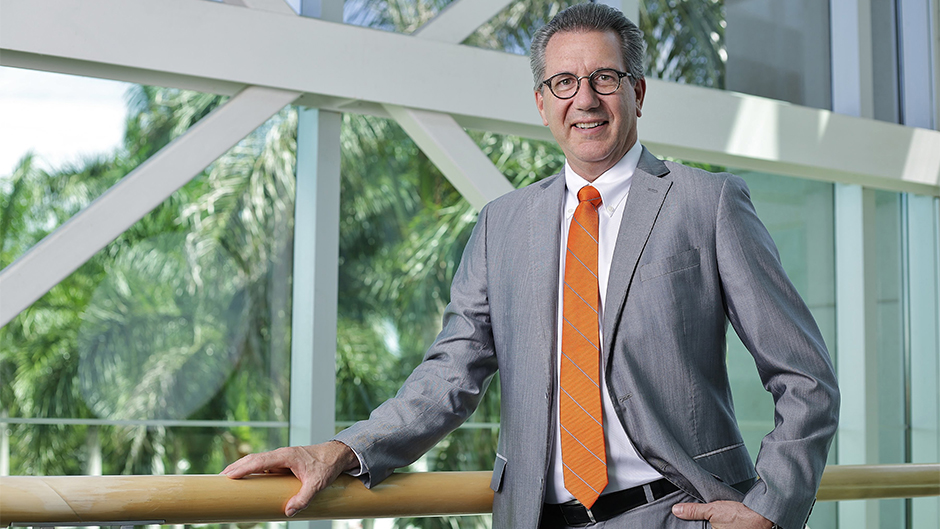When 6-year-old Jeffrey Duerk felt ready to ride a bike without training wheels, he didn’t tell his parents. Instead, he fished through his father’s toolbox, selected the appropriate wrench, and got to work. Though he succeeded in removing only one wheel, he learned a lifelong lesson.
“That can-do spirit, that entrepreneurial spirit—that’s a lot of what science is,” says Duerk, who joined the University of Miami in July as executive vice president and provost. “It’s having a sense that you can do something, then trying to do it, and if it doesn’t succeed, trying again.”
Still an avid cyclist, Duerk has been tinkering for the last 30 years not with training wheels but with the signals, sensors, and algorithms of magnetic resonance imaging (MRI), the indispensable medical tool that produces images of the human body without radiation.
MRI technology was in its infancy when Duerk—who holds a bachelor’s degree from Purdue University—was pursuing his master’s in electrical engineering at The Ohio State University. One day, a professor ended the lecture early and opened class to any topic. A fellow student asked about “this thing called nuclear magnetic resonance imaging.” The professor didn’t know what it was but vowed to find out.
“He came back and gave this lecture about quantum spin, magnetic fields, radio frequencies, digital signal processing,” Duerk recalls, “and I said this is what I want to do!”
Knowing that Cleveland, Ohio, was a hotbed for the burgeoning MRI industry, Duerk chose Case Western Reserve University for his Ph.D. in biomedical engineering. There, he joined an MRI lab “at basically the time the first human whole-body systems were becoming available,” he says.
Today Duerk holds some 40 patents, primarily for MRI innovations, and in 2017 was inducted into the National Academy of Inventors.
That quintessential symbol of invention—the light bulb—appears prominently atop two desk lamps in his office in the Ashe Building on the Coral Gables campus. One naked bulb sits on a steampunk-style machine; the other rests on an oversized silver flashlight. The zigzag filaments emit a captivating glow, but for Duerk, the lamps’ most alluring quality is their unusual pairing of objects.
In art as well as in education, Duerk looks for the creative intersections of objects, people, and ideas because, as he says, “the more interfaces you have, the more interesting things you can do. That’s one of the really great things about the University of Miami having 11 schools and colleges, as well as its various centers—all of these are opportunities to explore complex questions and solve different types of problems.”
Except for a few stints in the corporate world as a young scientist, Duerk developed his career at Case Western before coming to Miami. In 2005, at the request of the medical school dean at Case, he and an interdisciplinary group of colleagues from across campus drafted a proposal to invest in defining how medical imaging, genetics, drug discovery, and therapeutic evaluation could be linked. The dean’s response to their proposal: “This is interesting, but think bigger.”
The dean appointed Duerk founding director of what would emerge as the Case Center of Imaging Research, which has been a major player in fast-tracking discoveries into real-world applications. Expanding MRI from solely a diagnostic tool to an interventional one was among their key contributions.
“In order to capitalize on the full potential of MRI, we wondered if it was possible to image quickly enough to do an image-guided procedure,” Duerk explains. “One of our graduate students won an international young investigator award for the ability to deploy a stent in a renal artery completely under MRI guidance to the same accuracy as in, for example, a CT scan. The fact that this application of MRI now exists very widely, for specific indications—that’s pretty gratifying.”
Duerk also was a member of the interdisciplinary team of scientists and physicians who created and have advanced MR Fingerprinting, a quantitative technique that allows radiologists to more specifically identify and assess abnormalities than traditional MRI. And while leading the center, mentoring students, publishing papers, and acquiring patents—as well as raising two children with his wife, Cindy—Duerk was tapped to chair the Department of Biomedical Engineering and later to serve as dean of the School of Engineering.
Each time he confronts a new challenge, Duerk thinks back to his former dean’s “think bigger” advice, as well as a favorite quote by architect Daniel Burnham, which begins, “Make no little plans; they have no magic to stir men’s blood…”
The role of provost at the University of Miami was yet another opportunity to think big and broaden his scope of impact. In learning more about the University, in particular its hemispheric, excellent, relevant, and exemplary aspirations, Duerk wanted to be among the leaders who have the chance to “paint on this amazing canvas.”
“If you look at the leadership of the University of Miami today,” Duerk continues, “President Frenk has been here two years, [UHealth CEO] Steve Altschuler has been here two years—and we have new deans of the School of Business Administration, School of Nursing and Health Studies, and Miller School of Medicine. All of us came because we are builders. And it’s not about moving the needle from 9.9 to 9.95. Here the opportunity is to move the needle in big ways.”

